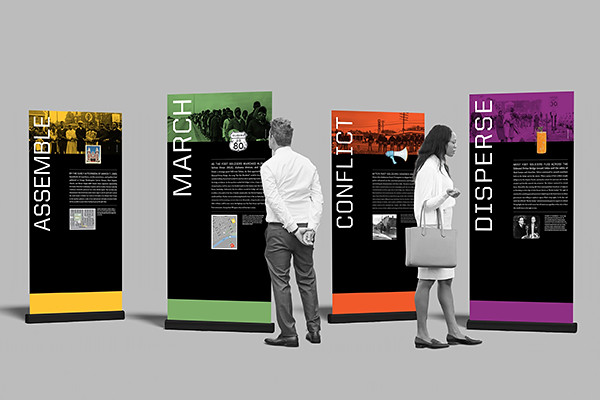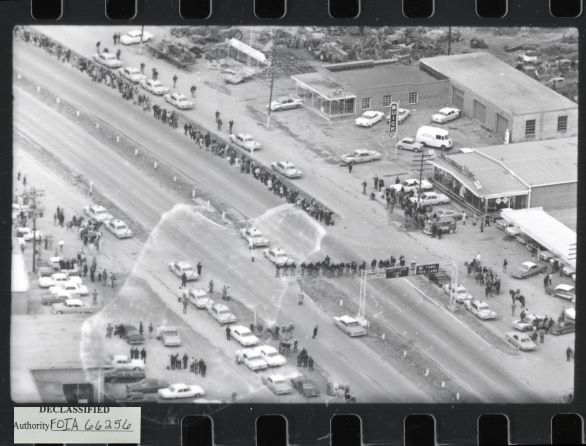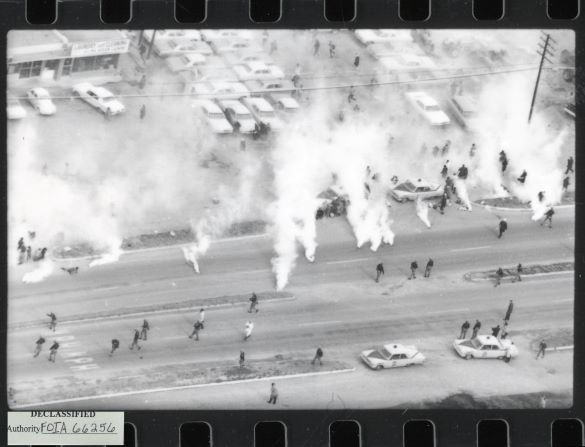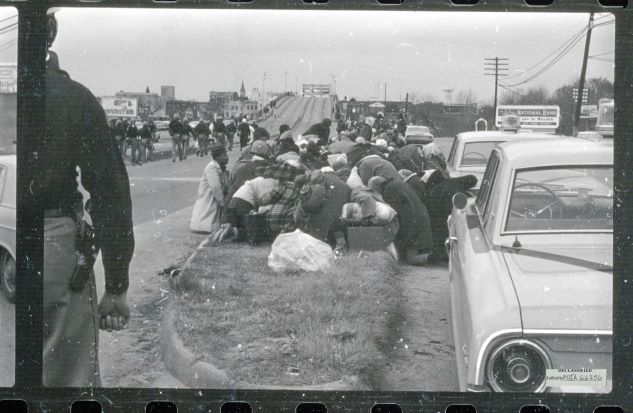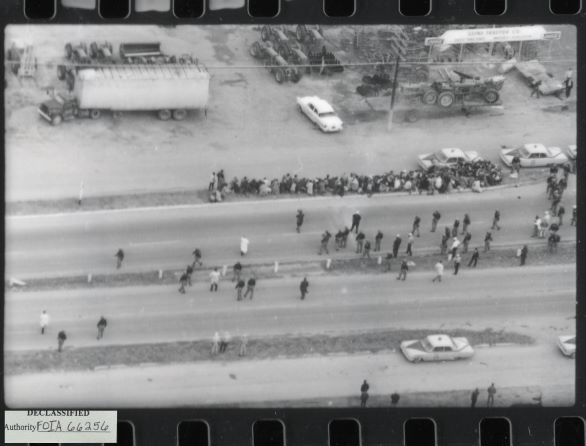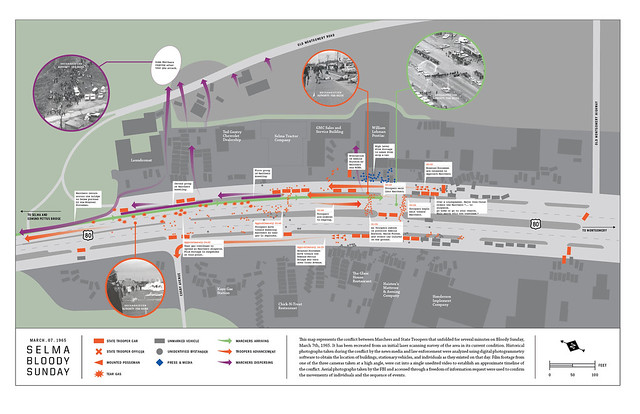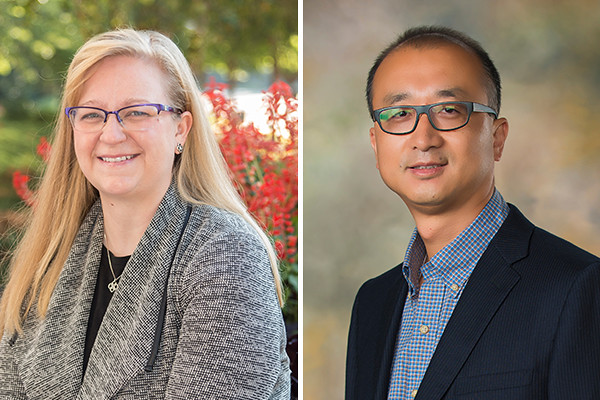Auburn-led research team to unveil enhanced declassified ‘Bloody Sunday’ FBI photos in Selma, Alabama, ahead of civil rights event’s 58th anniversary
Article body
An Auburn University-led interdisciplinary research team this weekend will unveil newly enhanced high-resolution images of declassified FBI photos taken from a seminal civil rights event in Selma, Alabama, now known as “Bloody Sunday.”
Photographs taken by FBI photographers from the ground and in surveillance aircraft from the March 7, 1965, incident were declassified in 2015, but had never been enlarged and enhanced via hi-resolution scans until now. Thanks to a successful Freedom of Information Act, or FOIA, request and a January trip to the National Archives in Washington, D.C., a joint Auburn-Georgia Institute of Technology research team has produced a collection of images that have never before been seen in such detail.
More than 150 images from that historic event and corresponding events will be part of the team’s Bloody Sunday research display at the Selma Bridge Crossing Jubilee March 3-5 in Selma, Alabama, just days before the 58th anniversary of the incident. Auburn Professors Richard Burt, Keith Hébert and Junshan Liu, along with former Auburn researcher and current Georgia Tech Assistant Professor Danielle Willkens, have been working on Bloody Sunday-related projects for years and continue to make major breakthroughs in setting the scene from the fateful day and identifying the marchers who participated.
The newly enhanced FBI images have helped validate the researchers’ findings and also provide extra detail about the roughly 300-yard area where the incident occurred. Thanks to the photos, Burt and his team have been able to add elements to and streamline a detailed map they have created of the historic location, as well as identify the brave individuals who participated in the march that day.
“Being able to see these images in such detail has greatly impacted our research,” said Burt, the McWhorter Endowed Chair and head of the McWhorter School of Building Science in the College of Architecture, Design and Construction. “Not only have we been able to confirm several of our contentions about what happened that day and specifics about the landscape of the area, but the photos have helped us enhance our map with greater clarity. This breakthrough was a team effort, and we look forward to sharing these images with the public and former marchers for the first time.”
On Bloody Sunday, John Lewis, Hosea Williams and a group of approximately 600 marchers were confronted by Alabama State Troopers armed with tear gas and metal batons as they began a march for equality toward Montgomery. The nation watched in horror that night on ABC as marchers were pummeled by law enforcement in an event that would serve as a catalyst for Americans across the country to rally behind the civil rights movement like never before.
A much larger group of marchers, including Dr. Martin Luther King Jr., would eventually complete the 50-mile journey to the state capital more than two weeks later on March 24 with the world watching. The event contributed greatly to the Voting Rights Act becoming law on Aug. 6 of that year and forever entrenched Selma in the history books.
Due diligence paying off
Willkens spearheaded the team’s FOIA request efforts, spending years overcoming roadblocks and navigating dead ends before successfully securing an approved permission to scan the photos.
“This is the culmination of a long and tough road, but we couldn’t be more pleased with the results,” she said. “These images are monumentally important to our research, and they have helped us paint a much clearer picture of the scene in Selma that day. I am proud to be part of this research team and know we will continue to make progress in telling this important story for months and years to come.”
Burt, Willkens and Liu—the Bob Aderholdt Endowed Associate Professor in Auburn’s College of Architecture, Design and Construction—traveled to the National Archives in the nation’s capital to perform the scans in early January and were amazed by the results. The process took days, but the detail provided by the photos sheds considerable new historical light on that day—including the presence of FBI surveillance planes in the skies above Selma and bureau photographers on the ground during the confrontation.
“As far as we know, it is not public knowledge that the FBI had planes in the air that day,” said Hébert, the Draughon Associate Professor of Southern History in the College of Liberal Arts. “The contact sheets of photos were declassified years ago, but the images are just now being shared with the masses in this type of detail for the first time. These developments are proof of how important FOIA requests can be for research and for accurately telling the whole story about historical events.
“Research like this is how we learn and grow as a society, and we are excited to be able to shine a light on the bravery of the Bloody Sunday marchers and those who fought for equality and the rights of all.”
Years of research
In 2016, concerned at the lack of preservation in the area where the conflict occurred, Burt and his research team began investigating the area to the east of the Edmund Pettus Bridge by using historical photos and video footage, photogrammetry software, laser scanners, drones and design concepts and technology to survey and map the area where the confrontation occurred. Burt’s team has been able to identify and chart the location of everything from local businesses, vehicles parked on the road and Alabama State Troopers, to the civil rights marchers, spectators and media, including the location of one of the cameramen who captured the events as they unfolded.
Burt and his team, along with graphic design faculty member Robert Finkel, have been able to largely recreate the scene from 1965 in the form of schematics and computerized plans in a pursuit to preserve the setting of Bloody Sunday. The team will display maps, images, research progress reports and other materials throughout the weekend as part of the Jubilee event lineup.
Burt, Hébert and others also have been diligently working to identify the marchers from Bloody Sunday, brave citizens dubbed “foot soldiers” by researchers. To date, the team has successfully identified approximately 90 of the hundreds of marchers and numbered 260 unique individuals from the historical photographs.
The team also turned to social media and the Selma community for help in making progress on its “Bloody Sunday” passion project, enlisting the help of a group of Auburn Honors College students to expand the project’s reach to the social media realm. Researchers in 2021 established a Facebook page where visitors can connect and help identify marchers who participated in the Selma event.
In addition, Burt and Hébert and have received considerable support from the Selma community, in particular the Selma City Council and Selma High School. Team members have formed relationships with several march participants and their families, as well as other individuals who were in attendance on Bloody Sunday.
The overarching hope for the project is to identify as many Bloody Sunday participants as possible and cement Selma’s status as a national historic site. Fewer than 100 exist in the United States.
“Selma, Alabama, needs to officially be recognized as a national historic site,” Hébert said. “It has been nearly 60 years since Bloody Sunday occurred, and we are slowly losing pieces of the area where the incident occurred. Bloody Sunday was one of the most important and pivotal moments in civil rights history, and the site and city need to be recognized as iconic landmarks from our nation’s history.”
Related Media
Media interested in this story can contact Communications Director Preston Sparks at (334) 844-9999 or preston.sparks@auburn.edu.
Auburn University is a nationally ranked land grant institution recognized for its commitment to world-class scholarship, interdisciplinary research with an elite, top-tier Carnegie R1 classification, life-changing outreach with Carnegie’s Community Engagement designation and an undergraduate education experience second to none. Auburn is home to more than 30,000 students, and its faculty and research partners collaborate to develop and deliver meaningful scholarship, science and technology-based advancements that meet pressing regional, national and global needs. Auburn’s commitment to active student engagement, professional success and public/private partnership drives a growing reputation for outreach and extension that delivers broad economic, health and societal impact.




